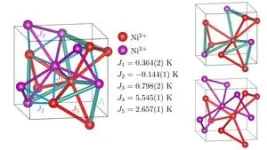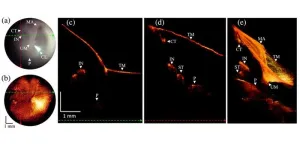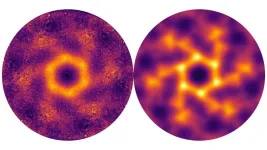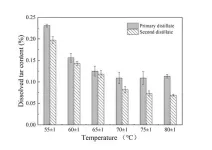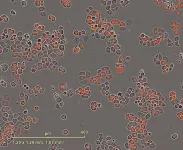(Press-News.org) Anibal Boscoboinik, a materials scientist at the U.S. Department of Energy’s (DOE) Brookhaven National Laboratory, has been named an “Inventor of the Year” by Battelle Memorial Institute. Battelle, headquartered in Columbus, Ohio, partners with Stony Brook University to form Brookhaven Science Associates, which manages the Lab on behalf of DOE’s Office of Science. Battelle manages or co-manages nine national labs across the country.
At Battelle’s yearly Celebration of Solvers, they award Inventor of the Year to an individual from each institution under Battelle management. The ceremony honors contributions to science or engineering that hold promise to positively impact society.
“I am very happy to represent Brookhaven National Lab with this award and thankful to all the people who contribute to the work that we do here,” Boscoboinik said. “There are lots of people participating, from the students and postdocs doing the research to the technical and administrative staff.”
Boscoboinik received the title this year for his role in developing materials that can trap and separate noble gases such as radon, xenon, krypton, and argon. It’s a tough task because these gases are inert, or unreactive.
Noble gases are typically separated out from gaseous mixtures by a process called cryogenic distillation, which requires condensing the noble gases at their respective freezing points. These points are very low across the board. However, many industries would benefit from capturing these substances at higher temperatures.
To work toward this goal, Boscoboinik studies 2D porous materials he calls nanocages at the Center for Functional Nanomaterials (CFN) and the National Synchrotron Light Source II, both DOE Office of Science user facilities at Brookhaven. These nanocages are much, much thinner than even a single sheet of paper — it would take 200,000 nanocages on top of one other to reach the thickness of a sheet of paper.
Boscoboinik stumbled upon the nanocages’ ability to contain noble gases above their frigid freezing points by fortuitous coincidence.
“We were trying to study the chemistry of a surface when we saw that it trapped noble gases. It was a complete accident. We were curious about it, so we published it, and then we started learning about the many applications that can result from trapping these gases,” he recalled.
During the 2020 National Lab Accelerator Pitch Event held by the Innovation and Partnerships Office at DOE’s Lawrence Livermore National Laboratory, Boscoboinik said, “You may wonder, ‘Why do we care about trapping noble gases?’ The truth is there are a variety of applications ranging from preventing lung cancer to industrial production.”
The first of these two addresses radon inhalation, which causes lung cancer and is responsible for tens of thousands of deaths annually in the U.S. alone. The Battelle award honors how Boscoboinik and his team’s radon-trapping nanocage technology could provide an affordable and effective method of removing radon from buildings.
“If we can get this material to trap the radon so people don't breathe it in, that would be something extremely useful,” he summarized. “So, we're thinking of ways to incorporate this technology into something like an air purifier.”
The second idea relates to facilitating the energy-efficient production of xenon and krypton, which could improve the efficiency of industries that produce lighting, anesthetics, electronics, and satellites.
Overall, the markets for Boscoboinik and his team’s award-winning technologies are worth hundreds of millions of dollars and could save many lives. To that end, Boscoboinik noted in a 2021 interview, “Nanoscience is fascinating. It can, and it will, change the world.”
Boscoboinik has a licentiate degree in chemistry from the Universidad Nacional de San Luis in Argentina. He earned his Ph.D. in chemistry in 2010 at the University of Wisconsin-Milwaukee. After a few years at the Fritz-Haber Institute of the Max-Planck Society in Berlin, Germany, he came to Brookhaven’s CFN in 2013. He previously won the Brookhaven Science and Technology Award in 2022 and the Alexander von Humboldt Fellowship in 2011.
Brookhaven National Laboratory is supported by the Office of Science of the U.S. Department of Energy. The Office of Science is the single largest supporter of basic research in the physical sciences in the United States and is working to address some of the most pressing challenges of our time. For more information, visit science.energy.gov.
Follow @BrookhavenLab on social media. Find us on Instagram, LinkedIn, X, and Facebook.
END
Battelle names Anibal Boscoboinik 'Inventor of the Year'
Honor recognizes advances in noble gas trapping technology with applications in industry and environmental health
2024-08-23
ELSE PRESS RELEASES FROM THIS DATE:
Toward a code-breaking quantum computer
2024-08-23
CAMBRIDGE, MA — The most recent email you sent was likely encrypted using a tried-and-true method that relies on the idea that even the fastest computer would be unable to efficiently break a gigantic number into factors.
Quantum computers, on the other hand, promise to rapidly crack complex cryptographic systems that a classical computer might never be able to unravel. This promise is based on a quantum factoring algorithm proposed in 1994 by Peter Shor, who is now a professor at MIT.
But while researchers have taken great strides in the last 30 years, scientists ...
New imaging device improves ear disease diagnosis
2024-08-23
In the realm of ear health, accurate diagnosis is crucial for effective treatment, especially when dealing with conditions that can lead to hearing loss. Traditionally, otolaryngologists have relied on the otoscope, a device that provides a limited view of the eardrum’s surface. This conventional tool, while useful, has its limitations, particularly when the tympanic membrane (TM) is opaque due to disease.
Enter a groundbreaking advancement from the University of Southern California's Caruso Department of Otolaryngology: a portable OCT otoscope that integrates optical coherence tomography (OCT) with ...
Langbeinites show talents as 3D quantum spin liquids
2024-08-23
A 3D quantum spin liquid has been discovered in the vicinity of a member of the langbeinite family. The material's specific crystalline structure and the resulting magnetic interactions induce an unusual behaviour that can be traced back to an island of liquidity. An international team has made this discovery with experiments at the ISIS neutron source and theoretical modelling on a nickel-langbeinite sample.
When spins in a crystal lattice cannot align to reach a minimum energy together, this is called magnetic frustration. ...
VA funds IU School of Medicine research projects relevant to veterans’ health
2024-08-23
INDIANAPOLIS – Indiana University School of Medicine researchers have cumulatively been awarded nearly $4 million in grant funding through the U.S. Department of Veterans Affairs' Merit Review Award and Career Development programs to support research on diabetes, skin inflammation, cancer and aging.
The Merit Review Award Program supports investigator-initiated research conducted by eligible VA investigators at either VA medical centers or approved sites. This program serves as the VA's primary method for funding basic, preclinical, ...
Researchers identify effective materials for protecting astronauts from harmful cosmic radiation on Mars
2024-08-23
Abu Dhabi, August 23, 2024: Researchers have identified specific materials, including certain plastics, rubber, and synthetic fibers, as well as Martian soil (regolith), which would effectively protect astronauts by blocking harmful space radiation on Mars. These findings could inform the design of protective habitats and spacesuits, making long-duration Mars missions more feasible. Because Mars lacks Earth’s thick atmosphere and magnetic field, astronauts exploring the planet would be exposed to dangerous levels of radiation.
Dimitra Atri, Investigator, ...
People seen as wise share these characteristics, according to a new study
2024-08-23
What makes someone seem wise? People view wisdom through the lens of applying knowledge and thinking logically as well as considering others’ feelings and perceptions, finds a new study led by University of Waterloo researchers who looked at perceptions of wisdom across 12 countries and five continents.
Researchers examined the underlying principles guiding who we perceive as wise in political leadership, science, and daily life. Across different cultures, participants’ judgements converged on two dimensions: reflective orientation and ...
Activated bamboo charcoal’s slow-release properties for enhanced anti-acne formulations containing bamboo vinegar
2024-08-23
Bamboo vinegar is a concentrated liquid obtained from bamboo under high temperature and anaerobic conditions. It contains more than 200 organic components, including organic acids, phenols, ketones, alcohols, and esters, among which acetic acid is the main component. Although bamboo vinegar has been approved by the China Food and Drug Administration as a cosmetic raw material, commercially available bamboo vinegar often contains impurities whose efficacy is not clear, and phenolic compounds and aromatic hydrocarbons ...
When is the best time of day for cancer treatment?
2024-08-23
How effective medications are depends on various factors, including the time of day when they are administered. Why? Because our bodies don’t always function exactly the same. Instead, they follow the cycle set by their internal clock, otherwise known as circadian rhythm. But since each person’s circadian rhythm is different and depends on a number of different factors, it is difficult to tailor medication schedules to an individual patient’s body clock. Researchers at Charité – Universitätsmedizin Berlin have now developed a method for determining the optimum time of cancer treatment based on certain breast cancer ...
Rates of obesity-related cancer are rising sharply in young Chinese people
2024-08-23
Obesity-related cancer rates in China were rising at an alarming 3.6% every year between 2007 and 2021 while non-obesity-related cancers remained stable, according to the first comprehensive study published August 22 in the Cell Press journal Med. The increase is particularly pronounced among young people, highlighting the urgent need for better public health policies to address China’s growing overweight and obesity rates.
“If we don’t drastically change the obesity epidemic, the rates of cancer associated with obesity will inevitably continue to rise,” says Jin-Kui Yang, the paper’s corresponding author and an endocrinologist ...
Neighborhood-level disparities in hypertension prevalence and treatment among middle-aged adults
2024-08-23
About The Study: Researchers found corresponding increases in hypertension prevalence as neighborhood disadvantage and the percentage of Black patients residing in a neighborhood increased in this cross-sectional study. A higher burden of midlife hypertension was identified in Black adults compared with other racial and ethnic groups that persisted across levels of socioeconomic disadvantage. This study also found that living in socioeconomically disadvantaged neighborhoods was associated with higher hypertension ...
LAST 30 PRESS RELEASES:
A new way to map how cells choose their fate
Numbers in our sights affect how we perceive space
SIMJ announces global collaborative book project in commemoration of its 75th anniversary
Air pollution exposure and birth weight
Obstructive sleep apnea risk and mental health conditions among older adults
How talking slows eye movements behind the wheel
The Ceramic Society of Japan’s Oxoate Ceramics Research Association launches new international book project
Heart-brain connection: international study reveals the role of the vagus nerve in keeping the heart young
Researchers identify Rb1 as a predictive biomarker for a new therapeutic strategy in some breast cancers
Survey reveals ethical gaps slowing AI adoption in pediatric surgery
Stimulant ADHD medications work differently than thought
AI overestimates how smart people are, according to HSE economists
HSE researchers create genome-wide map of quadruplexes
Scientists boost cell "powerhouses" to burn more calories
Automatic label checking: The missing step in making reliable medical AI
Low daily alcohol intake linked to 50% heightened mouth cancer risk in India
American Meteorological Society announces Rick Spinrad as 2026 President-Elect
Biomass-based carbon capture spotlighted in newly released global climate webinar recording
Illuminating invisible nano pollutants: advanced bioimaging tracks the full journey of emerging nanoscale contaminants in living systems
How does age affect recovery from spinal cord injury?
Novel AI tool offers prognosis for patients with head and neck cancer
Fathers’ microplastic exposure tied to their children’s metabolic problems
Research validates laboratory model for studying high-grade serous ovarian cancer
SIR 2026 delivers transformative breakthroughs in minimally invasive medicine to improve patient care
Stem Cell Reports most downloaded papers of 2025 highlight the breadth and impact of stem cell research
Oxford-led study estimates NHS spends around 3% of its primary and secondary care budget on the health impacts of heat and cold in England
A researcher’s long quest leads to a smart composite breakthrough
Urban wild bees act as “microbial sensors” of city health.
New study finds where you live affects recovery after a hip fracture
Forecasting the impact of fully automated vehicle adoption on US road traffic injuries
[Press-News.org] Battelle names Anibal Boscoboinik 'Inventor of the Year'Honor recognizes advances in noble gas trapping technology with applications in industry and environmental health

